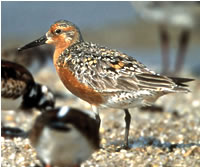

|
The red knot is truly a master of long-distance aviation. On wingspans of 20 inches, red knots fly more than 9,300 miles from south to north every spring and repeat the trip in reverse every autumn, making this bird one of the longest-distance migrants in the animal kingdom. Surveys of wintering knots along the coasts of southern Chile and Argentina and during spring migration in Delaware Bay on the U.S. coast indicate a serious population decline.
Red knots' unique and impressive life history depends for its success, and the species' survival, on certain conditions. One of the most important is the continued availability of billions of horseshoe crab eggs at major North Atlantic staging areas, notably the Delaware Bay and Cape May peninsula. The increase in taking of horseshoe crabs for bait in commercial fisheries that occurred in the 1990s may be a major factor in the decline in red knots. Another necessary condition for red knots' survival is the continued existence of middle- and high-arctic habitat for breeding. Red knots could be particularly affected by global climate change, which may be greatest at the latitudes where this species breeds and winters.
Biologists from the U.S. Fish and Wildlife Service, state natural resource agencies, and non-profit organizations all share a concern for this race of red knot and are pooling efforts to identify what needs to be done to prevent further losses. Together with these partners, the U.S. Fish and Wildlife Service is dedicated to working to conserve this extraordinary bird.
THE RED KNOT IN THE NEWS
- July 20, 2007— Red knot status assessment report available
- Sept. 12, 2006 — Red knot named candidate for Endangered Species Act protection
- Sept. 12, 2006 — Service updates list of candidate species for Endangered Species Act listing
- June 24, 2004 — $223,000 Federal Grant Supports Conservation of Imperiled Shorebird in Delaware Bay and South America
- June 9, 2004 — Secretary Norton Announces Grants ... to Conserve Migratory Birds
FOR MORE INFORMATION
- Status of the Red Knot in the Western Hemisphere (July 20, 2007) (16 MB download)
- Federal Register notice adding red knot to candidate list (Sept. 12, 2006)
- Facts about the red knot
- Shorebirds: The Delaware Bay Connection
- Facts about the horseshoe crab
- Pages one and two of Petition to List the Red Knot as an Endangered Species (Leo) (does not include eight additional pages of 106 additional signatures)
- Fish and Wildlife Service reply to Petition to List the Red Knot as an Endangered Species (Leo)
- to Petition to List the Red Knot as an Endangered Species (Leo)
- Emergency Petition for a Rule to List the Red Knot ... as Endangered ... (Defenders et al.)
- Petition to List the Red Knot ... as Endangered ... (Riverkeeper et al.)
- Fish and Wildlife Service reply to Defenders, Riverkeeper and others (same letter to all)
- Information on threatened and endangered species and the Service's endangered species program
THE RED KNOT ALONG THE EAST COAST
- Red knot characteristics (New Hampshire Public Television)
- Red knot characteristics and identification (Cornell Lab of Ornithology)
- Red knot in New Jersey (New Jersey Dept. of Environmental Protection)
- Red knot body stores in Arctic breeding ground (BioOne)
- Survival rates of red knots in Delaware Bay (British Trust for Ornithology)
- Red knot Strategies in Delaware Bay (British Trust for Ornithology)
- Red knot arrival and weight gains in Delaware Bay (British Trust for Ornithology)
These links go to non-Fish and Wildlife Service sites: